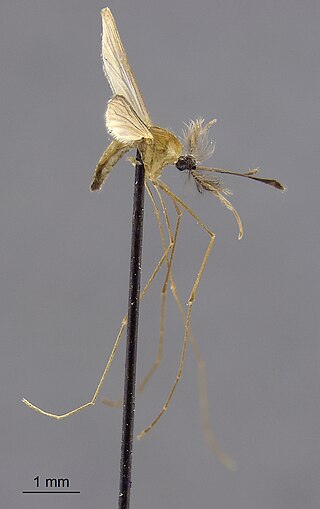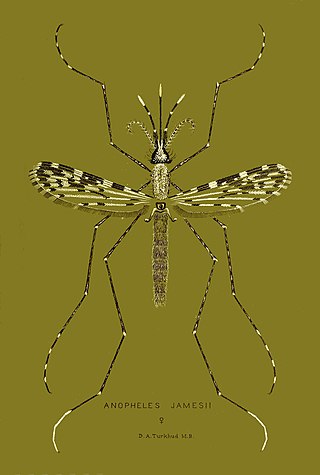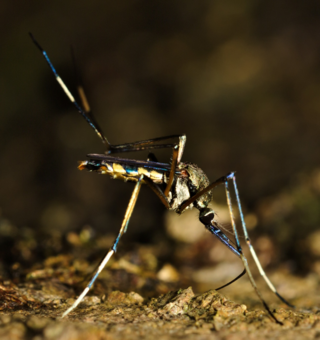
Anopheles stephensi is a primary mosquito vector of malaria in urban India and is included in the same subgenus as Anopheles gambiae, the primary malaria vector in Africa. A. gambiae consists of a complex of morphologically identical species of mosquitoes, along with all other major malaria vectors; however, A. stephensi has not yet been included in any of these complexes. Nevertheless, two races of A. stephensi exist based on differences in egg dimensions and the number of ridges on the eggs; A. s. stephensisensu stricto, the type form, is a competent malaria vector that takes place in urban areas, and A. s. mysorensis, the variety form, exists in rural areas and exhibits considerable zoophilic behaviour, making it a poor malaria vector. However, A. s. mysorensis is a detrimental vector in Iran. An intermediate form also exists in rural communities and peri-urban areas, though its vector status is unknown. About 12% of malaria cases in India are due to A. stephensi.

Anopheles barbirostris is a species complex of mosquito belonging to the genus Anopheles. Larvae found in clean, lotic bodies of water. Females are zoophilic, mainly feed blood on cattle and humans. It is also an important vector for Plasmodium falciparum in Sri Lanka and Timor, for both Plasmodium vivax and P. falciparum in Bangladesh.
Anopheles barbumbrosus is a species complex of mosquito belonging to the genus Anopheles. It has 12-36 thin attenuated branches usually loose and separated out, which is a good indication to separate it from A. barbirostris. It shows a marked zoophilic tendency, thus is a malaria vector, but with minor importance to humans. It is distributed throughout Peninsular Malaysia, Sumatra, Java, Thailand, India and Sri Lanka, They mostly live as an outdoor mosquito species, rarely found indoor places. Larva can be found in a variety of habitats including both partially shaded and sunlit fresh and slowly running water, grass-fringed streams to stagnant water pools and man-made places like rice fields.

Anopheles insulaeflorum is a species complex of mosquito belonging to the genus Anopheles. It is found in India, Sri Lanka, Cambodia, China, Indonesia, Malaysia, Myanmar, Philippines, Taiwan, Thailand, and Vietnam.
Anopheles interruptus is a species complex of mosquito belonging to the genus Anopheles. It is found in India, Sri Lanka, Borneo, Brunei, Cambodia, China, Malaysia, Nepal, Thailand, and Vietnam.

Anopheles (Cellia) jamesii is a species complex of mosquito belonging to the genus Anopheles. It is found in India, and Sri Lanka, Bangladesh, Cambodia, China, Laos, Malaysia, Myanmar, Nepal, Thailand, and Vietnam. It is a potential natural vector of bancroftian filariasis in Sri Lanka.
Anopheles (Cellia) karwari is a species complex of zoophilic mosquito belonging to the genus Anopheles. It is found in India, and Sri Lanka, Bangladesh, Sumatra, and Java. A. karwari is a member of the Maculatus Group and the second scarcest species reported from Indonesia. Female is blood sucking and involved in transmitting Plasmodium falciparum, thus an important malarial vector. It is considered a secondary vector in the Australian region, but its vectorial status in South-East Asia was unknown.
Anopheles (Anopheles) peditaeniatus is a species complex of mosquito belonging to the genus Anopheles, of the Hyrcanus Group. It is found in India, and Sri Lanka, Iran, and Bangladesh. It is a potential natural vector of bancroftian filariasis in Sri Lanka.
Anopheles (Cellia) tessellatus is a species complex of zoophilic mosquito belonging to the genus Anopheles. It is found in India, and Sri Lanka, Bangladesh, Cambodia, China, Indonesia, Malaysia, Laos, Maldives, Myanmar, Nepal, Philippines, Taiwan, Thailand and Vietnam. It is first described from Sri Lanka. Larvae are known to found from dirty stagnant water in sun or shady habitats. Adults are zoophilic. It is not regarded as a malaria vector, but is a secondary vector of Wuchereria bancrofti in Maldives.
Anopheles (Cellia) vagus is a species complex of zoophilic mosquito belonging to the genus Anopheles. It is found in India, Sri Lanka and Indonesia. It is a potential natural vector of malarial parasite Plasmodium falciparum, and Japanese encephalitis virus. It is highly susceptible to insecticide deltamethrin and resistant to DDT.
Anopheles (Cellia) varuna is a species complex of zoophilic mosquito belonging to the genus Anopheles. It is found in India, Sri Lanka Thailand and Vietnam. It is a secondary malaria vector in Sri Lanka. Larvae are known to feed on detritus, rod and cocci bacteria, diatom, filamentous algae and desmids. A microsporidium Thelohania obscura was discovered from the larvae in India in 1966.
Aedes (Hulecoeteomyia) chrysolineatus is a species complex of zoophilic mosquito belonging to the genus Aedes. It is found in Sri Lanka, India, Japan, Malaya, Thailand, Indochina, Sumatra, and Java.
Aedes (Bruceharrisonius) greenii is a species complex of zoophilic mosquito belonging to the genus Aedes. It is found in Sri Lanka India, Indonesia, Malaysia, Nepal, Philippines and Thailand.
Aedes (Stegomyia) krombeini is a species complex of zoophilic mosquito belonging to the Scutellaria group of the genus Aedes. It is endemic to Sri Lanka.
Aedes (Paraedes) ostentatio is a species complex of zoophilic mosquito belonging to the genus Aedes. It is found in Sri Lanka, Malay, India, Indochina, Indonesia, Philippines, Laos, Thailand, Vietnam and Maluku.
Armigeres (Armigeres) aureolineatus is a species complex of zoophilic mosquito belonging to the genus Armigeres. It is found in Sri Lanka, India, Malaya, Cambodia, Laos, Nepal, Philippines, Vietnam, Thailand, Indochina, China, and Borneo. Larvae are collected from discarded containers, coconut shells and dirty water pools. It is known as a vector for avian diseases and few mammalian diseases.
Heizmannia (Heizmannia) greenii is a species complex of zoophilic mosquito belonging to the genus Heizmannia. It is found in Sri Lanka, India, Malaya, Cambodia, Laos, Nepal, Philippines, Vietnam, Thailand, Indochina, China, and Borneo.

Toxorhynchites (Toxorhynchites) splendens is a species of non-hematophagous mosquito belonging to the genus Toxorhynchites. It is widely used as a predator to control dengue mosquitoes.
Culex (Lutzia) fuscanus is a species of mosquito belonging to the genus Culex. It is found in China, India, Indonesia and Sri Lanka They are natural predators of disease causing mosquito larva such as Aedes aegypti, Anopheles subpictus, and Culex tritaeniorhynchus.




